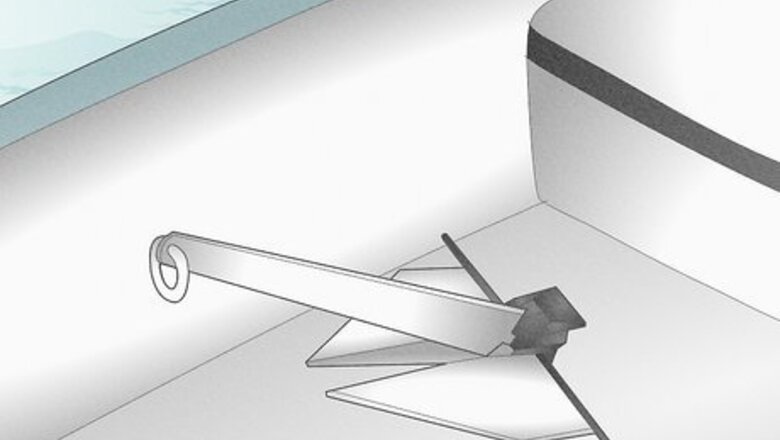
views
Selecting Proper Equipment

Consider a general purpose fluke anchor. A fluke or Danforth anchor relies less on its weight than on its design, which consists of two flat, pointed flukes extending at a 30º angle from the anchor rod. This is one of the more popular designs on the market, and in soft mud or hard sand, has more staying power by weight than any other type. However, its broad-fluked design may prevent it from reaching bottom in a strong current, and like most anchors, it will have trouble catching on rocks and other hard bottoms. Aluminum variations of the Danforth design, such as the Fortress, have excellent holding power. Some of these also have adjustable flukes, which can be made broader when anchoring in soft mud. A large aluminum fluke anchor may make a good storm anchor.
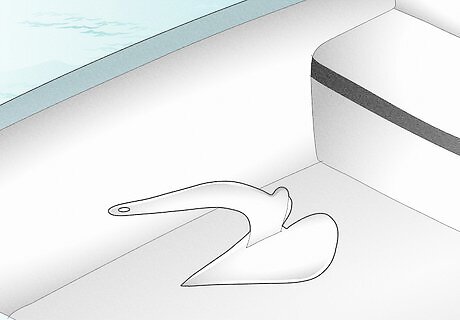
Research plow anchors for areas of high or changing current. The plow anchor is named for the plow-shaped wedge attached by a swivel to the shaft. It is effective in soft bottoms, and somewhat better in grass than other lightweight anchors. These tend to be heavier than fluke anchors of the same size, and thus will set more easily (though with somewhat less holding power) than fluke anchors. The ability of the shaft to swivel in the direction it is pulled without yanking the main anchor makes the plow anchor less likely to unfasten when the boat is pulled a different direction. Plow anchors have no protruding flukes or pieces that the anchor line or chain can catch on. However, unless you have a bow roller, plow anchors can be difficult to store.
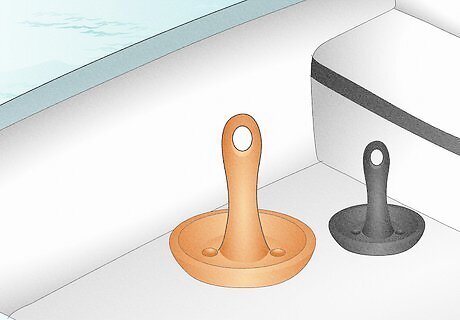
Only use mushroom anchors for light use. Mushroom anchors look like a disc or dish at the base of the anchor shaft. They don't have much holding power, but are a good choice for small boats that make short stops in areas with soft ground. If your boat is small enough for the size of mushroom anchor you choose, it may be your best bet for heavily weeded areas. If poking a hole in your vessel is a concern, mushroom anchors have no sharp edges and are less likely to damage thin hulled boats such as composite canoes, kayaks and inflatables. Many electric anchors lowered by the push of a button are mushroom anchors.

Research other types of anchors for specialized uses. Many more types of anchor exist, and no single anchor is useful for every purpose. Grapnel, navy, or Herreshoff anchors are useful for anchoring small boats to rocky bottoms. Less common bottoms may require specialized anchors for best results, such as a claw anchor in gravel.

Use several anchors for different purposes. Depending on what you use your boat for, you'll probably want several anchors of different sizes. Your main anchor is useful for extending fishing spots and most other purposes. An anchor one or two sizes smaller that's easy to deploy and pull up is good for lunch stops and other short breaks. A storm anchor one or two sizes larger should be kept around to deploy during rough weather or for overnight stops. In addition, it's always good to have at least one heavy backup in case you lose an anchor, or for situations where it's wise to use two anchors. Make sure your anchor is the proper weight and size for your boat, as well as the proper type of anchor for the bottom of the lake, ocean, or sea that you're going to be anchoring to. You should always follow the recommendations of your boat's manufacturer when picking anchor size. However, a rough chart can be found halfway down this page. Purchase a larger anchor than specified if you have an unusual amount of weight on your boat. When in doubt, purchase a larger anchor. Physical size is a more important indicator than weight, although both are relevant.
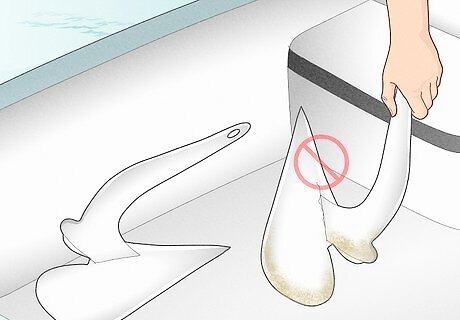
Use high quality anchors. Anchors are important for your safety, and you should buy the best anchors you can afford. Inspect each anchor for rust, uneven or breaking welding lines, and other inconsistencies in the metal before purchasing.
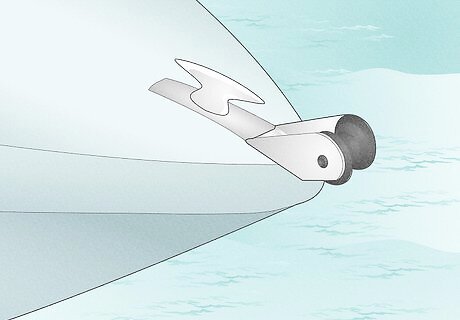
Make sure you have deck cleats or anchor rollers suitable for your anchors. You may have a bow roller mounted on your boat where you can store and attach your anchor, but be aware that each roller is only suitable for specific types of anchors. Otherwise, make sure you have strong, sturdy deck cleats to tie the anchor rope onto.
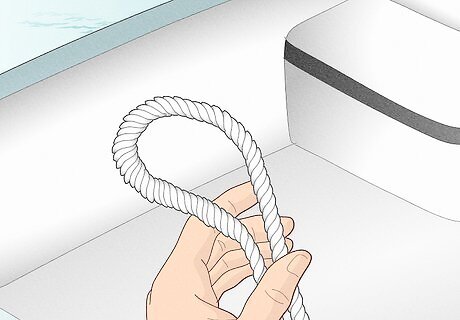
Learn how to pick a nylon anchor line. The chain, rope, or combination of these that attaches the anchor to your boat is called an anchor rode. Nylon's elasticity allows it to respond well to sudden wind and current changes, and a high quality rope is sufficiently strong to use as a rode. It is also easy to manipulate and relatively cheap, although you should not skimp on quality. Three stranded nylon rope is most resistant to tears and thus best suited for water bottom purposes, but it will become difficult to handle and need to be replaced after it is stiff with salt. Choose medium lay three stranded rope, referring to the number of twists in the strands, as it will come apart less easily. Braided nylon rope is stronger and easier to work with, but not a great option for frequent anchor use, as it snags or tears from objects on the bottom. When you anchor your boat, always be sure the rode is free and clear, so it's able to run out of the boat cleanly.
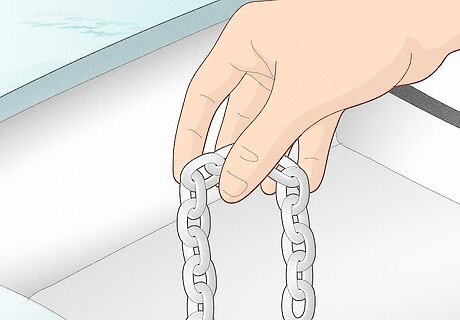
Understand which anchor chain is best to use. Chain is more expensive and takes more effort to use, but won't be fouled by strong currents and helps the anchor drop to the bottom quickly. Try to find anchor chain with high quality of manufacture and consistent galvanization, indicated by a uniform appearance. Good choices for chain types to use in anchor applications include BBB, Hi-test chain, and proof coil. Make sure the chain's links fit on your boat's windlass, which stores the chain and releases it as you drop the anchor. Proof coil chain has a "G 3" imprinted on each link. BBB chain is a strong material with small links suitable for small windlasses. It is preferred by people who use all-chain anchor ropes rather than a mix of rope and chain. Hi-test chain is strong but light. Use it instead of the others if you'd like to reduce weight. Anchor chain made by North American companies is a more consistent quality than some anchor chains of other countries. If you live elsewhere in the world and don't wish to buy an imported chain, local sailors or fishermen may be able to advise you.

Consider using both materials. An anchor rode formed from lengths of both rope and chain provides some of the benefits and downsides of each, but requires an additional shackle joint to keep the two lengths tightly fastened. In the end, the chain vs. rope discussion has many factors involved, and you may want an experienced boat owner to help you make the decision. If you use an all-chain rode, it is still a good idea to attach a nylon rope "snubbing line" to make the rode heavier and more elastic. One end of this rope is tied to a bow cleat, while a special chain hook tool attaches the other to the chain 4 feet (1.2m) or more from where the chain is attached to the bow.

Use rope or chain of sufficient diameter. Nylon rope should be 3/16" (4.8mm) in diameter for a craft under 10' (3m) in length and 3/8" (9.5mm) for a craft under 20' (6m). Increase the diameter by an additional 1/8" (3.2mm) for each additional 10' (3m) in length beyond 20 feet (6 meters). Chain can be 1/8" (3.2mm) smaller in diameter than rope would be for that size of boat.
Choosing a Spot to Anchor
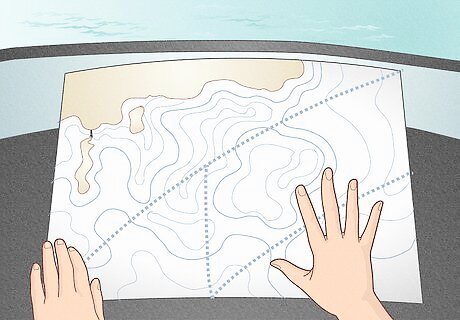
Use your charts and eyesight to choose a good location. Your charts should tell you the depth of the water and note any designated anchoring locations. Try to find a location with a flat bottom suitable for your anchor type (soft and relatively weed-free is usually best). Avoid areas of strong current or areas open to the weather, especially during an overnight stop. If you're aiming to end up over a fishing spot or other specific area, keep in mind the anchor location should be well upwind of the area your boat will end up.
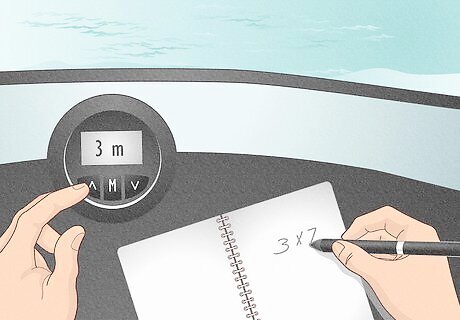
Measure the depth at that location and check the space available. Measure the depth of the chosen spot and multiply by 7: this is roughly how far your boat will drift from your anchor. If the current or wind changes, your boat could swing to the other side of the anchor; make sure it has sufficient space in every direction. Never anchor your boat somewhere where its swing radius will intersect another boat's. Never assume the other boats have the same anchor line (or "anchor rode") length as you do, or that they will drift in the same direction. Ask other boat owners where their anchors are dropped and how long the rode is if you're not sure. The instructions below give you more exact instructions for determining the length of your anchor line.
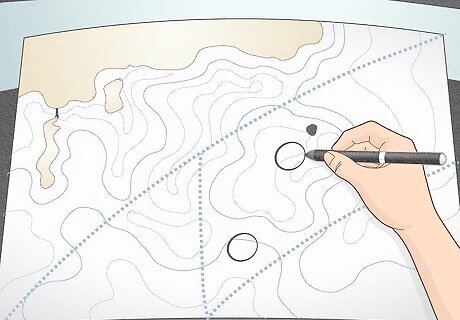
Circle the possible anchorage location while making depth measurements. Circle the spot you've chosen fully, taking depth measurements. This will reveal any hidden shoals or other obstructions that could damage your boat if it drifts while anchored. If you do find dangerous shallow areas, you'll need to find another place to drop anchor.
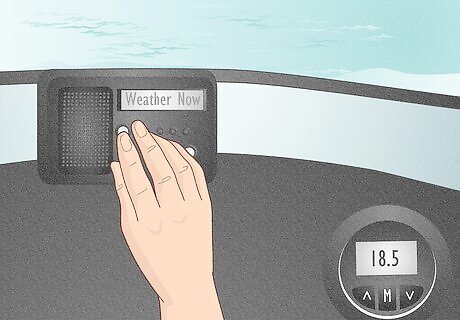
Check the weather and tide information. You should know the timing of the next tide and the range of water level between high tide and low tide, so you aren't caught unawares. If you're staying longer than an hour or two, you should check the weather forecast so you're prepared for any high wind or storms.
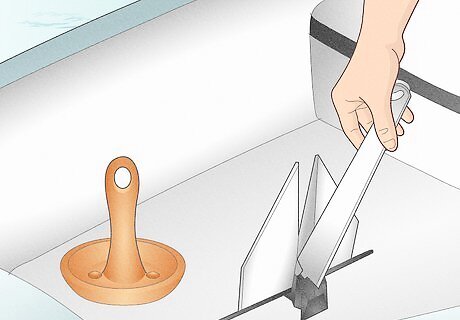
Consider which anchor to use. You should now have a good idea of the nature of your location. If you expect high winds or a strong tide, or if your anchor coming loose could cause a collision, you should use a heavy storm anchor with excellent holding power. For most situations, your ordinary main anchor or light "lunch anchor" will do. See Selecting an Anchor for more information. In rough circumstances, you may need to use one anchor at the bow and a second anchor at the stern. Only do this if nearby boats are using this method, as boats using one or two anchors swing by different amounts and easily foul each other's lines.
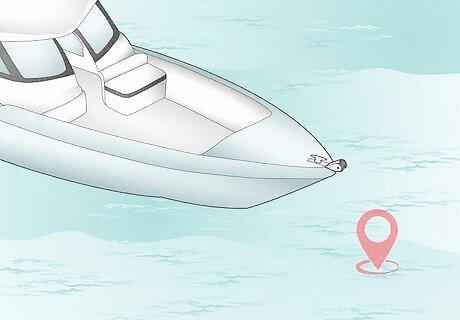
Slowly approach the confirmed spot from downwind and stop when over it. When you stop, the current or wind should push you slowly backward away from the spot. This is when you should drop the anchor. If the water is calm, you may need a helmsman to reverse the engines at idle speed. It's better to work out hand signals for "start", "stop", "more power", and "less power" in advance, rather than attempting to shout across the boat.
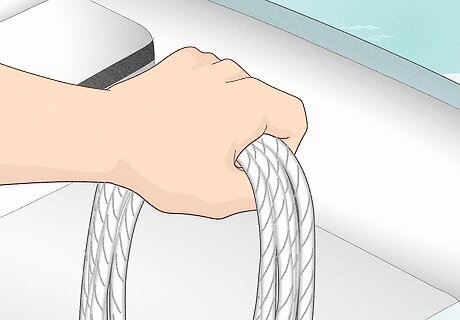
Determine how much line to let out and cleat it at that point. Before you drop your anchor, determine how much you'll line, or rode, you'll need, then use a cleat hitch to tie it at that distance. The term scope refers to the ratio between the length of your rode and the distance from the bow to the bottom. Your scope should be at least 5:1, but 7:1 is preferable. Increase the scope to 10:1 or more for stormy conditions or if your anchor keeps ripping free of the bottom. The longer the scope, the closer to horizontal your rode is, and the more tightly you will be anchored. Measure from the bow, not the water surface. If the water is 10 feet deep (3m), and your bow is 4 feet (1.2) m above the water surface, the total depth is 14 feet (4.2m). A typical scope of 7:1 would require 14 x 7 = 98 feet of rode (4.2 x 7 = 29.4 m). Consult a knot guide for sailors or online tutorial if you do not know how to tie a firm cleat hitch. Only use a shorter scope than listed if you need to avoid drifting into obstacles and cannot find any suitable anchorage spot with more space. Do not rely on a short scope for rough weather or overnight stays.
Dropping Anchor

Slowly lower your anchor over the bow (front of the boat). Keep the anchor rode tight at first to help you aim the anchor until you feel it hit bottom. Then slowly play out the rode. It should end up in a straight line across the bottom, not piled up in a heap that could get tangled. Be sure to stop the boat completely before you deploy the anchor. Be careful to avoid getting your hands or feet caught in the rode, which could cause serious injury. Instruct passengers of the danger and keep kids and animals away. Don't throw your anchor overboard; let it down slowly to avoid fouling your own rope. Never drop an anchor from the stern unless there is already an anchor holding the bow and you need extra anchorage. Anchoring from the stern only could cause your boat to capsize.

After 1/3 of the rode has been let out, cinch it off and let the boat straighten. Your boat will probably turn across the current or wind as you move. After you've let out about 1/3 of the total rode you determined you'd use, cinch it off and wait for the boat to straighten out. This will straighten the rode you've let out and gently set the anchor into the bottom. If your boat won't straighten out, your anchor is drifting and you need to try again. Pick another spot if possible.
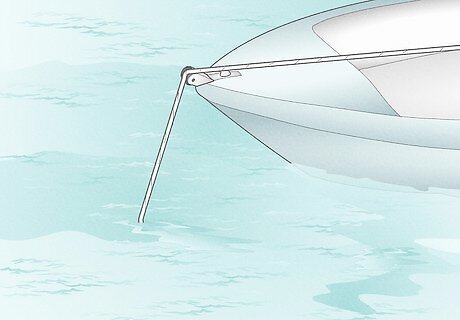
Continue to let out the scope and straighten the boat twice more. Uncinch the anchor rode and let it out as the boat once again drifts backward. Cinch it again once a total of 2/3 the rode length has been played out. Let the boat's momentum straighten it out and set the anchor more firmly. Repeat this process one more time, letting out the rest of the rode length you determined was necessary.
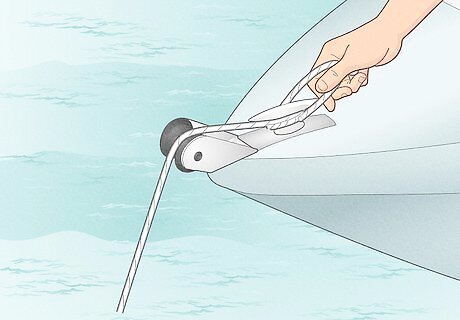
Tie off the line around a bow cleat. Tie the anchor rode firmly around a bow cleat. Give it a tug to test the anchor is set, although be aware it will require further setting as described below. If not, you'll need to repeat this process. Try to find a different spot with better conditions. It's a good idea to secure the anchor to the boat with a backup secure in case the primary rode were to fail for some reason.
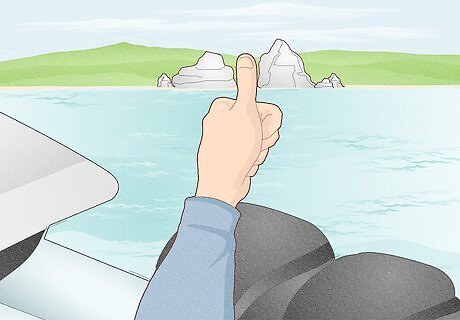
Check you're anchored using reference points. First, find two stationary objects on the shore, and note their positions relative to each other from your perspective. (For instance, a tree in front of a lighthouse, or two boulders a thumb's width apart if you hold your hand at arm's length.) Signal the helmsman to gently start the engine in reverse until the rode straightens, then signal him or her to return to neutral. The boat should drift back to a stationary position where the two objects you noted appear in exactly the same position relative to each other. If the two objects are in different positions and you remained standing in the same spot throughout this procedure, you are not anchored and need to begin again. Try to arrange hand signals with your helmsman in advance, rather than attempting to shout across the boat.
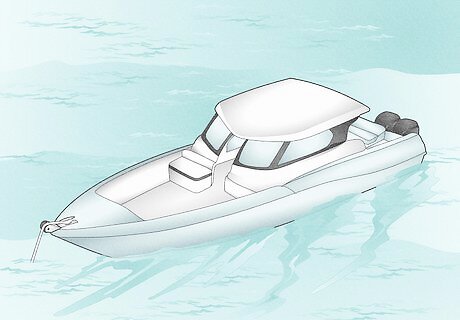
Use your engine to give the anchor a final hard set. This is called snubbing the anchor, and jams a set anchor more firmly into the bottom. Have your helmsman reverse hard until the rode straightens out, then kill the engine. Check your bearings again as your helmsman does this, to double check the anchor hasn't pulled free.

Take compass bearings regularly. Take the bearings of several objects around you and note them in your log book. Do this immediately after anchoring, and 15–20 minutes after anchoring to make sure the anchor set properly. Keep checking every hour or few hours, depending on how long you'll be anchored. GPS units often have an alarm setting that will alert you if you drift. If you are going to be staying overnight, try to find at least one object that will be lit. If you can't, you should use a GPS unit. For an overnight stay or other long stop, arrange an anchor watch rotation in advance so the crew can take turns checking to make sure you haven't drifted.




















Comments
0 comment